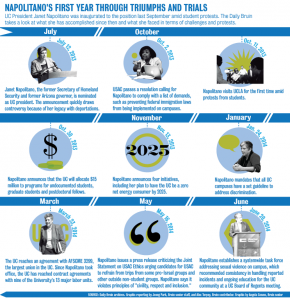Students wanted Janet Napolitano out of office even before she took the helm as the University of California president.
At her first University of California Board of Regents meeting in July last year, six protesters were arrested as they demanded the regents withdraw her appointment, upset that she did not have a background in academia and that she had overseen a record number of deportations as Secretary of Homeland Security.
Her appointment process itself drew criticism, with several UC community members accusing the regents of giving too little time and notice of her nomination before she was appointed. Regents appointed Napolitano less than a week after she was nominated. Since then, Napolitano has spent her term working to convince the UC that she is listening and open to their thoughts.
Tuesday marks the conclusion of Napolitano’s first year as the UC president, a job she has performed more like a politician than as an academic as her predecessors have done.

During her first year on the job, Napolitano – the UC’s first female president and the first to come from a prominent political background – has tried to address the criticism she faced by funding programs for undocumented students and negotiating several successful labor contracts, as well as reaching out to University stakeholders like students and faculty.
She has also worked to shape the University’s influences in state and national affairs, stressing the UC’s role as a research university by launching several initiatives not related just to education but instead to national and state issues like sustainability and relations with Mexico, as well as relationships with the California State University and California community colleges. Napolitano was not available for comment for this story.
Acknowledging she did not come from an academic or UC background, Napolitano kicked off her year with a University-wide tour during the first months of her presidency, visiting all 10 UC campuses and having dozens of meetings with University stakeholders. Some, like Caroline McKusick, a UC Davis graduate student of the United Auto Workers Local 2865 union, have said they think these meetings are only staged publicity stunts.
“On campus tours, she listens to hand-picked groups of students,” McKusick said. “It’s not real democracy when you’re talking in a closed room in a secret location.”
Seth Ronquillo, a UCLA alumnus and former Daily Bruin columnist who served last year as a co-chair of UCLA’s Improving Dreams, Equality, Access and Success, an undocumented student group, said despite the outreach and actions Napolitano took in support of undocumented students, he thinks the community hasn’t seen enough. Undocumented students have been Napolitano’s loudest critics since her nomination last year.
“Napolitano knows she is politically vulnerable,” Ronquillo said. “The pain is still there for undocumented students when you know the leadership is responsible for separating families.”
Others, however, said they think Napolitano has been more effective in listening to University members and has improved relations between the UC Office of the President and students. Over the course of her first year, she held three Google Hangout chats with students, staff and alumni and formed advisory groups with groups like student veterans and lesbian, gay, bisexual and transgender individuals to address issues they face on campus.
Cinthia Flores, who served as the UC student regent for the academic year of 2013-2014, said she thinks Napolitano has been open to student input.
“(She) and I had established a relationship in which if she was interested in a student issue, I would gather opinions from students and present them to her,” Flores said.
Napolitano has also tried to be more communicative in addressing thorny relations with the UC staff, as she inherited unfinished negotiations between the University and 10 labor units. Within about the first eight months of her presidency, the UC finished contract negotiations with those labor units, which labor leaders attributed to the Napolitano administration’s willingness to work with them.
American Federation of State, County and Municipal Employees 3299 President Kathryn Lybarger said she thinks Napolitano has been more communicative with the union, helping to form a contract with which both parties are satisfied.
AFSCME 3299, which represents about 20,000 service and patient care workers at the UC, finally came to a contract agreement in March with the University after nearly two years of negotiations that also included two strikes.
“(Napolitano) intervened at key moments to move the negotiation along,” Lybarger said. “That was not lost on us.”
Napolitano also took over the UC presidency at a time when the state was beginning to reinvest in the University, while it simultaneously faced increasing costs like pension payments.
Nathan Brostrom, UC executive vice president – chief financial officer, said Napolitano’s background as a former Governor of Arizona and Secretary of Homeland Security has led her to find ways to communicate with staff and make the University run more efficiently. Napolitano launched an efficiency review in October at the UC Office of the President to identify areas where costs can be cut and cutbacks to her own office in January.
“It’s in her nature, having been a governor, to see (administrative efficiency) as a top priority, and fortunately it meets (our needs),” Brostrom said.
One of the bigger projects Napolitano is currently working on is a plan to reform the UC’s tuition policy, which could change how tuition levels are decided for each class of students in a year.
In the meantime, Napolitano has said she wants to constantly remain in touch with students.
“This is part of our ongoing efforts to be in touch with students,” she said during her first webchat with students in January. “We need to constantly be challenging ourselves about not only what we’re doing, but what we can and should be doing for the future.”